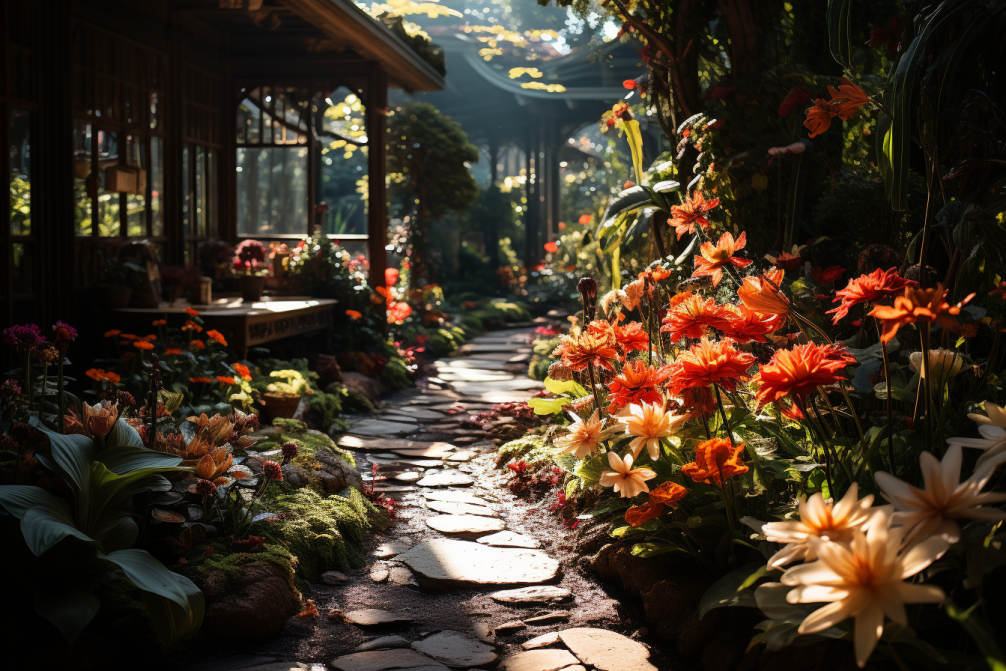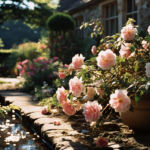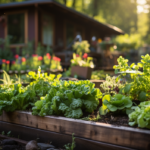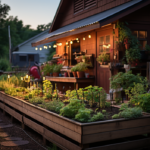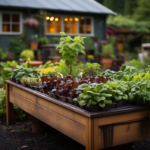Table of Contents
From Seed to Blossom: A Comprehensive Guide to Choosing and Cultivating the Ideal Flowers for Your Garden
Hey there fellow green thumbs! Welcome to Flower Gardening 101: Selecting and Growing the Perfect Blooms. If you’ve always dreamt of having a vibrant and beautiful garden full of stunning flowers, then you’ve come to the right place.
In this guide, we’ll take you from a flower gardening beginner to a blossoming expert. We’ll dive into the nitty-gritty of selecting the perfect blooms for your garden and provide you with all the tips and tricks you need to ensure success in growing them.
Whether you’re looking to add some vibrant colors to your backyard, create a fragrant oasis on your patio, or even start a small flower farm, we’ve got you covered. From delicate roses to cheerful sunflowers, we’ll help you navigate through the vast array of flower options and find the ones that suit your preferences and needs.
But selecting the right flowers is just the beginning. Growing them successfully is where the real magic happens! We’ll guide you through the entire process, from planting seeds or bulbs to caring for your flowers as they grow and thrive. There’s no need to worry if you’re an absolute beginner because we’ll break everything down into simple steps and share insider tips to make your gardening journey enjoyable and rewarding.
So grab your gardening gloves and get ready to embark on a flowery adventure like never before. Let’s dig into this guide and watch your garden burst into a symphony of vibrant colors and sweet scents!
Assessing Your Garden Space and Conditions
When it comes to flower gardening, one of the first and most crucial steps is assessing your garden space and conditions. Before you start picking out your favorite blooms, it’s essential to understand the unique characteristics of your garden and how they can influence your flower choices.
First and foremost, take a good look at your garden’s size and layout. Evaluate the available space, whether it’s a small patch, a raised bed, or a sprawling backyard. Assessing the size of your garden will help you determine how many flowers you can accommodate and plan accordingly.
Next, consider the amount of sunlight your garden receives throughout the day. Some flowers thrive in full sun, while others prefer partial or even full shade. Knowing the sun exposure in your garden will help you select the right plants that will flourish in those conditions.
Another aspect to consider is your soil quality and drainage. Some flowers need well-draining soil, while others can tolerate heavy or clay-like soil. Understanding your soil type will ensure that you choose flowers that can thrive and will not succumb to issues like root rot.
Climate and hardiness zones should also be taken into account. Different flowers have different temperature and climate requirements. Knowing your region’s hardiness zone will help you select flowers that are more likely to survive and thrive in your area.
Lastly, choose flower types that match your space and gardening goals. Whether you want to create a colorful border, a fragrant corner, or even a container garden, there are flowers that suit every setting. Consider factors like height, spread, and maintenance requirements when selecting flowers for your specific garden space.
By carefully assessing your garden space and conditions, you are setting a strong foundation for successful flower gardening. Next up, we’ll explore the exciting world of flower selection and how to choose the perfect blooms for your garden.
Understanding Bloom Types and Their Unique Needs
When it comes to selecting the perfect blooms for your garden, it’s essential to understand the different types of flowers and their unique needs. In the world of flower gardening, there are three main categories: annuals, perennials, and biennials.
Annual flowers are the life of the party, providing a burst of vibrant colors every year. These flowers have a short lifespan, typically completing their life cycle within a year. They bloom quickly from seed and often produce an abundance of flowers throughout the growing season. Annuals are perfect for adding splashes of seasonal color and filling gaps in your garden.
Perennial flowers are the reliable staples of any garden. Unlike annuals, perennials continue to grow and bloom for several years, bringing beauty and charm to your space season after season. While they may have shorter blooming periods compared to annuals, perennials often return bigger and stronger each year. They are the backbone of a well-established garden and require less maintenance once established.
Biennial flowers are the enigmatic middle ground between annuals and perennials. These plants have a two-year life cycle. In their first year, they grow foliage, and in the second year, they produce flowers, set seeds, and complete their life cycle. Biennials offer the excitement of a fresh start each year while still providing the opportunity to enjoy the rewards of their stunning blooms.
Understanding different bloom types allows you to match them to your gardening goals. If you crave constant color and variety year after year, annuals may be your go-to choice. For a low-maintenance and long-lasting display, perennials are the stars. And if you want a mix of both, biennials can add an element of surprise and intrigue to your garden.
When selecting flowers for your garden, consider the bloom types that align with your preferences, maintenance capabilities, and desired garden aesthetic. Remember to also take into account factors such as your gardening zone, sun exposure, and soil conditions, as these will impact the success and longevity of your blooms.
Now that you understand the different bloom types, it’s time to move on to the exciting part: choosing specific flower varieties that will elevate your garden to new heights.
Best Flowers for Different Climates and Seasons
When it comes to flower gardening, it’s important to select flowers that are well-suited for your climate and the different seasons throughout the year. Understanding which flowers thrive in certain conditions will help you create a garden that blooms beautifully throughout the seasons.
If you live in a hot and dry climate, opt for flowers that are drought-tolerant and can withstand the intense heat. Succulents such as sedum, yucca, and agave are excellent choices, as they have adapted to thrive in arid environments. Other options include cosmos, zinnias, and marigolds, which are known for their ability to withstand heat and require minimal watering.
For shady areas of your garden, there are plenty of flowers that can bring color and vibrancy to these darker spots. Try planting impatiens, begonias, or hostas, as they can tolerate less direct sunlight. Ferns and astilbes are also great choices for adding texture and greenery to shaded areas.
If you live in a cooler climate with a shorter growing season, consider planting flowers that are adapted to these conditions. Delphiniums, foxgloves, and poppies thrive in cooler climates and add vertical interest to your garden. Don’t forget about spring-blooming bulbs like tulips, daffodils, and hyacinths, which are perfect for welcoming the warmer months.
To ensure continuous blooms throughout the seasons, plan your garden with seasonal flowers and employ successional planting. This means staggering your planting times for different flowers so that as one variety finishes blooming, another begins to showcase its beauty. This method ensures a continuous display of color and maximizes the use of your garden space.
Lastly, consider the allure of native flowers. Native plants are adapted to your local climate and ecosystem, making them well-suited for your garden. By incorporating native flowers, you can create a garden that supports local wildlife, requires less maintenance, and celebrates the natural beauty of your region.
By choosing flowers that thrive in your specific climate and aligning them with the different seasons, you can create a garden that bursts with color and life all year round. Next, we’ll delve into the secrets of planting and nurturing your chosen blooms for optimal growth and beauty.
Selecting the Right Flowers Based on Your Preferences
When it comes to selecting the perfect flowers for your garden, it’s all about tailoring your choices to match your preferences and the overall style you want to achieve. Here’s how you can pick the right flowers based on your personal taste and gardening style:
Begin by assessing your preferences. Think about the colors, shapes, and fragrances that resonate with you. Do you prefer bold and vibrant blooms or soft and pastel hues? Are you drawn to the delicate beauty of roses or the exuberant charm of sunflowers? Identifying your preferences will help you narrow down the flower choices that truly speak to your heart.
Next, determine your garden style. Do you prefer a formal garden with symmetrical designs and structured plantings? Or perhaps a whimsical cottage garden filled with an abundance of flowers and a carefree atmosphere? Maybe you prefer the natural beauty of wildflowers that evoke a sense of untamed wilderness. Understanding your desired garden style will guide you in selecting flowers that fit seamlessly into that aesthetic.
Consider the maintenance and care requirements of the flowers you’re interested in. Some flowers require more attention and upkeep than others. If you have limited time or prefer low-maintenance plants, look for flowers that are known to be resilient and easy to care for.
Research the characteristics of different flowers, such as their height, spread, and bloom time. This will help you determine how they will fit into your garden and create a harmonious arrangement. Mixing flowers with varying heights and bloom times will add depth and visual interest to your garden.
Lastly, think about combining complementary flowers to create stunning visual impact. Choose flowers that have complementary colors, textures, or shapes. By strategically planting complementary flowers, you can create eye-catching combinations that will make your garden truly stand out.
By selecting flowers that align with your preferences, gardening style, and maintenance capabilities, you can create a garden that reflects your unique personality and brings you joy. Don’t be afraid to experiment and have fun with your selections – after all, gardening is about expressing your creativity while enjoying nature’s beauty.
With these essential aspects in mind, you are now ready to embark on your flower gardening journey. Get ready to experience the satisfaction of selecting and growing the perfect blooms that will transform your garden into a breathtaking floral paradise.
Starting from Seeds or Opting for Blooming Plants
When it comes to flower gardening, one decision you’ll need to make is whether to start from seeds or opt for blooming plants. Both options have their own advantages and considerations. Here’s what you need to know:
Starting from seeds can be a rewarding and cost-effective way to grow your garden. It allows you to have control over the entire plant growth process, from germination to maturity. Plus, there’s something magical about witnessing the transformation of a tiny seed into a beautiful blooming flower. Some benefits of starting from seeds include:
- Variety: Seeds offer a wide range of flower options that may not be readily available as blooming plants.
- Cost: Seeds are generally more affordable than buying blooming plants, especially if you’re looking to fill a large garden space.
- Learning Experience: Starting from seeds provides a hands-on learning opportunity, allowing you to understand the plant’s life cycle and develop greater gardening skills.
On the other hand, if you want immediate beauty in your garden, buying blooming plants is the way to go. These plants have already gone through the germination process and are ready to display their gorgeous blooms right away. Benefits of opting for blooming plants include:
- Instant Gratification: You get to enjoy immediate beauty without the wait and uncertainty of seed germination.
- Timing: If you want your garden to look stunning for a specific event or season, buying blooming plants ensures you have the right flowers at the right time.
- Easier Maintenance: Since blooming plants are already established, they often require less attention and care compared to starting from seeds.
If you decide to start from seeds, there are various techniques you can explore, such as direct seeding or starting indoors. Each method has its own considerations, including soil preparation, watering, and providing adequate light.
When making the choice between seeds and blooming plants, consider factors like cost, time, and personal preference. It’s also perfectly fine to find a balance between the two. You can start some flowers from seeds and supplement with blooming plants for immediate impact and a diverse garden.
Ultimately, the choice between starting from seeds or opting for blooming plants depends on your gardening goals, budget, and patience. Whichever route you take, the joy of seeing your garden flourish with perfect blooms will make it all worth it.
Planting Techniques and Best Practices
When it comes to planting your chosen blooms, following proper techniques and best practices ensures optimal growth and success. Here are some essential tips to keep in mind:
Preparing the Soil for Planting Success:
- Start by removing any weeds, rocks, or debris from the planting area.
- Loosen the soil using a garden fork or tiller, allowing for better root penetration.
- Amend the soil with organic matter like compost to improve its structure and fertility.
Providing Adequate Watering and Drainage:
- Water your plants deeply and consistently, ensuring the soil is evenly moist but not waterlogged.
- Provide drainage by adding organic matter or using raised beds to prevent waterlogging.
- Avoid overwatering, as it can lead to root rot, while underwatering can cause wilting and stunted growth.
Giving Your Plants the Right Amount of Sunlight:
- Study the sunlight requirements of your chosen flower varieties.
- Ensure your plants receive the appropriate amount of sunlight based on their needs.
- Place sun-loving plants in full sun areas while providing shade or partial shade for shade-loving flowers.
Mulching for Moisture Retention and Weed Control:
- Apply a layer of organic mulch around your plants, such as wood chips or straw.
- Mulching helps retain moisture, regulate soil temperature, and suppress weed growth.
- Avoid piling mulch against the plant’s stem to prevent rot and disease. Leave a small gap around the base.
Regular Maintenance and Pruning for Healthy Growth:
- Remove dead or faded flowers (known as deadheading) to encourage continuous blooming.
- Prune your plants as needed to maintain shape, promote branching, and remove damaged or diseased parts.
- Monitor your garden for pests and diseases and take appropriate action to prevent or treat any issues.
By following these planting techniques and best practices, you set your flowers up for healthy growth, vibrant blooms, and overall garden success. Remember to always read the specific care instructions for each flower variety, as different plants may have unique requirements. With proper care and attention, your garden will thrive and transform into a picturesque display of perfect blooms.
Nurturing Your Blooms: Watering, Fertilizing, and Pruning Tips
Nurturing your blooms is essential for their health, growth, and overall beauty. Proper watering, fertilizing, and pruning techniques will help your flowers reach their full potential. Here are some tips to guide you:
Providing Proper Watering Techniques for Healthy Plants:
- Water your plants deeply and thoroughly, allowing the water to reach the roots.
- Aim to water in the morning or evening when temperatures are cooler, reducing water loss due to evaporation.
- Avoid overhead watering, as it can promote fungal diseases. Instead, water at the base of the plants.
Understanding the Role of Fertilizers in Plant Growth:
- Choose the right fertilizer formulation based on your plant’s needs, such as balanced or slow-release fertilizers.
- Follow the recommended dosage instructions provided on the fertilizer packaging.
- Apply fertilizers at the appropriate times, such as during the growing season or when plants show signs of nutrient deficiencies.
Pruning for Healthy Growth and Shapely Blooms:
- Regularly prune your plants to remove dead or damaged branches and encourage new growth.
- Prune your flowering plants after they have finished blooming to maintain their shape and promote future blooms.
- Use sharp pruners or shears to make clean cuts, and disinfect your tools between plants to prevent the spread of diseases.
Tackling Common Issues and Troubleshooting:
- Monitor your plants for signs of pests and diseases, such as yellowing leaves or wilting.
- Research natural and organic methods to control pests, like using insecticidal soap or introducing beneficial insects.
- Address nutrient deficiencies or imbalances by adjusting your fertilization practices or using specific nutrient supplements.
Remember that each plant has its own specific needs, so it’s crucial to research and understand the requirements of the flowers you’re growing. Observe your plants closely, as they will often communicate their needs through visual cues. By providing proper care and addressing any issues promptly, you can help your blooms thrive and continue to delight you with their beauty.
With these nurturing tips in your gardening arsenal, you’ll be well-equipped to keep your flowers happy and healthy throughout the growing season. Get ready to enjoy the rewards of your hard work as your garden becomes a haven of perfect blooms.
No products found.
Dealing with Common Pests and Diseases in Flower Gardens
While flower gardening is a rewarding endeavor, pesky pests and diseases can sometimes disrupt the beauty of your blooms. It’s crucial to be prepared and equipped with the knowledge to tackle these issues. Here’s what you need to know:
Identifying Common Pests and Diseases in Flower Gardens:
- Be on the lookout for common garden pests like aphids, slugs, snails, and spider mites.
- Keep an eye out for signs of diseases such as powdery mildew, black spot, and root rot.
- Regularly inspect your plants for any visible damage or abnormalities that may indicate the presence of pests or diseases.
Natural Pest Control Methods to Protect Your Blooms:
- Consider using natural remedies like insecticidal soap, neem oil, or diatomaceous earth to control pests.
- Encourage beneficial insects like ladybugs, lacewings, and praying mantises that prey on garden pests.
- Use physical barriers like netting or row covers to protect your flowers from pests.
Prevention Techniques to Keep Pests and Diseases at Bay:
- Practice good garden hygiene by removing dead plant material and fallen leaves to prevent disease spread.
- Rotate your flower varieties to prevent the buildup of pests and diseases in the soil.
- Maintain proper plant spacing to ensure good air circulation, reducing the risk of diseases.
Understanding the Importance of Proper Plant Hygiene:
- Regularly clean your gardening tools, pots, and containers to prevent the spread of diseases.
- Remove and dispose of infected plants promptly to prevent the spread of diseases to healthy plants.
- Avoid overwatering, as it can create a favorable environment for fungal diseases.
Seeking Professional Help When Necessary:
- If pests or diseases become overwhelming and natural remedies prove ineffective, consider seeking professional assistance from a local garden center or extension service.
- They can provide expert advice tailored to your specific situation and recommend appropriate treatments.
By being proactive and implementing preventative measures, you can minimize the risk of pests and diseases in your flower garden. Regular monitoring, quick action, and a healthy plant environment are key to maintaining the beauty and health of your blooms. Enjoy the process of tending to your garden and overcoming challenges, and remember that with a little care, your flower garden will flourish.
No products found.
Maximizing Blooms: Sunlight and Soil Requirements
For your flowers to reach their full blooming potential, providing the right sunlight and soil conditions is vital. Here’s what you need to know to maximize blooms in your garden:
Understanding the Importance of Sunlight in Flower Growth:
- Sunlight is crucial for photosynthesis, the process by which plants convert sunlight into energy.
- Most flowering plants require a minimum of 6 hours of direct sunlight per day to thrive and produce abundant blooms.
- Insufficient sunlight can lead to leggy plants, reduced flowering, and weaker stems.
Choosing Flowers Based on Sunlight Requirements:
- Before selecting flowers, assess the sunlight conditions in your garden, considering factors like available sun exposure and nearby shade from buildings, trees, or other structures.
- Sun-loving flowers like roses, marigolds, and zinnias thrive in full sun areas, while shade-tolerant flowers such as impatiens, begonias, and hostas prefer partial or dappled shade.
Evaluating Soil Types and Their Impact on Blooms:
- Different plants have specific soil requirements, including pH levels, drainage, and nutrient content.
- Conduct a soil test to determine the characteristics of your soil, such as its pH level and nutrient composition.
- Well-draining soil is essential for healthy root development, preventing issues like root rot.
Improving Soil Health with Organic Amendments:
- Amend the soil with organic matter like compost, well-rotted manure, or peat moss to improve its structure, water retention, and nutrient content.
- Organic matter helps create a healthy soil ecosystem, providing essential nutrients and promoting beneficial microbial activity.
Providing Optimal Conditions for Maximum Blooming:
- Ensure your flowers receive the appropriate amount of sunlight based on their requirements.
- Water your plants regularly and deeply, keeping the soil evenly moist but not waterlogged.
- Mulch around your plants to conserve moisture, regulate soil temperature, and suppress weed growth.
- Fertilize your flowers with a balanced or bloom-specific fertilizer to provide necessary nutrients.
By understanding the sunlight and soil requirements of your flowers, you can provide optimal conditions for maximum blooming. Creating the right environment will result in healthier plants, robust blooms, and a stunning flower garden. Be sure to research the specific needs of each variety, adjust your gardening practices accordingly, and watch your blooms flourish.
No products found.
Extending Your Flower Garden’s Blooming Season
- Incorporating Early Bloomers and Late Bloomers into Your Garden Design
- Using Succession Planting for Continuous Blooms
- Deadheading to Encourage New Flower Growth
- Selecting Flowers with Extended Blooming Periods
- Providing Care and Maintenance to Prolong the Blooming Season
Who doesn’t want their flower garden to have a longer blooming season? With some strategic planning and care, you can extend the beauty and enjoyment of your flower garden. Here’s how:
Incorporating Early Bloomers and Late Bloomers into Your Garden Design:
- Include early-blooming flowers like crocuses, daffodils, and tulips to bring color and joy at the start of the growing season.
- Incorporate late-blooming flowers such as asters, chrysanthemums, and sedums to keep your garden vibrant well into the fall.
Using Succession Planting for Continuous Blooms:
- Sow seeds or plant new flowers in stages, staggering the planting times throughout the season.
- This technique ensures a continuous display of blooms as one set of flowers fades, the next one takes its place.
Deadheading to Encourage New Flower Growth:
- Regularly remove faded flowers by deadheading, cutting off the wilted blooms just above a node or set of leaves.
- Deadheading stimulates the plant to produce new growth and more flowers rather than directing energy toward seed production.
Selecting Flowers with Extended Blooming Periods:
- Choose flower varieties known for their extended blooming periods, such as coneflowers, geraniums, and petunias.
- Look for cultivars labeled as “ever-blooming” or “long-blooming” to ensure a prolonged display of flowers.
Providing Care and Maintenance to Prolong the Blooming Season:
- Maintain proper watering practices, ensuring your flowers receive enough moisture without overwatering.
- Regularly fertilize your plants with a balanced fertilizer to provide them with essential nutrients for prolonged blooming.
- Monitor your plants for pests, diseases, and other issues, addressing them promptly to prevent any setbacks to the blooming season.
By incorporating early and late bloomers, using succession planting, deadheading spent flowers, selecting long-blooming varieties, and providing proper care, you can extend the blooming season of your flower garden. With careful planning and attention, your garden will be bursting with vibrant colors and delightful blooms for a more extended period, bringing joy and beauty throughout the seasons.
Conclusion
Congratulations on completing Flower Gardening 101: Selecting and Growing the Perfect Blooms! Armed with the knowledge and tips you’ve acquired, you’re well on your way to creating a stunning flower garden that will brighten your days and bring joy to all who behold it.
From assessing your garden space and understanding bloom types to selecting flowers based on preferences and maximizing blooms with proper care, you’ve gained essential insights into the world of flower gardening. With each step, you’ve learned how to choose the perfect flowers, plant them effectively, nurture them, and overcome challenges that may arise along the way.
Remember that gardening is a journey filled with experimentation, learning, and the joy of witnessing nature’s wonders unfold. Don’t be afraid to try new varieties, mix and match colors, or let your creativity shine through your garden design.
As you embark on your flower gardening adventure, stay in tune with the needs of your plants. Adapt your care routine as necessary and seek guidance when faced with unfamiliar pests or diseases. With time and experience, you’ll become an expert in nurturing your blooms and creating a garden that reflects your unique personality and style.
So grab your gardening tools, put on your sun hat, and let your passion for flowers guide you. Enjoy the process, embrace the beauty of nature, and watch as your garden transforms into a breathtaking tapestry of perfect blooms. Happy gardening!

